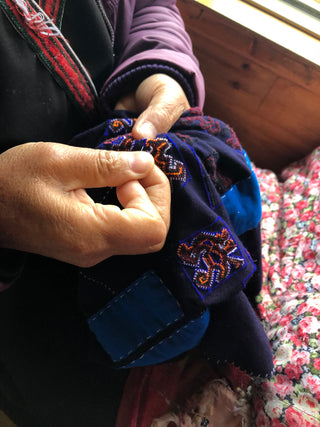It would be a mistake to write about the Yao culture without mentioning their traditional sewing and embroidery techniques-- particularly among the Red Yao community.
We will be exploring this topic further as our understanding deepens, and we invite you to come along for the journey. Below, you'll find some of the interesting facts we discovered on our last visit to the village.
A Long History of Sewing
According to the local community, the sewing culture of the Yao people dates back more than 1900 years. This doesn't seem surprising when you see the intricate beauty of the Red Yao's garments with your own eyes.
And the fine details and bold colors are even more stunning when accompanied by the women's long, vibrant black hair.
It's a combination that seems to have evolved into perfection...

Among the Yao minority, there are dozens of subgroups-- of which the Red Yao is one. Their red garments are so unique and essential to their culture that they derived their name from this tradition. Each Yao lady has several striking outfits, all of which are handmade and worn daily, even when working in the rice paddies.
They proudly wear their most precious and unique outfits to celebrate special occasions like weddings, birthdays, and visiting relatives. It can take up to three years to complete an outfit worthy of these special occasions.
Of course, using a wooden loom can considerably speed up the process; however, the ladies often prefer to make these outfits by hand, preserving their tradition and skill for exquisite embroidery.

Color plays such an interesting role in how the Red Yao women dress. Young women usually wear colorful red and pink outfits, but the women start to wear darker colors that are more modest as they reach a certain age. Occasionally, young women will dress in darker colors, but this is typically only done when attending a funeral.
Yao ladies begin to learn sewing and embroidery techniques as young as 12 or 13-- so it's not surprising that they're so skilled! Learning at this early age and committing countless hours to practice this traditional skill makes them very masterful by the time they're 15 or so. Perhaps not coincidentally, this is also the young age at which they used to get married.
And a wedding is the perfect occasion for a bride to showcase her most beautiful garment.

But, as we've written about before, times have changed. Not all Red Yao women, especially the younger generation, place importance on this ancient tradition. Exposure to the outside world and a natural curiosity to evolve has led to the adoption of new values and interests and less active participation in traditional customs.
When asked about the abandoning of this cultural heritage, the elderly ladies seemed (perhaps surprisingly) to understand the younger generation's change in attitude. From their perspective, they see their children presented with new opportunities-- ones they never had.
They are very encouraging of their children's desire to learn more about the world, get a formal education, and gain experience in the cities. Yet, when asked what their dream life looks like, overwhelmingly, the answer is the same: to live with family and friends in their hometown practicing their traditional culture.
We find this comforting to hear as we often ponder how to balance cultural preservation and the communities' own desire to evolve and explore.

That answer reminds us that it's the people that form a culture. Traditions might come and go, but as long as the people within that culture keep living together, individuals within that community will preserve or re-introduce valuable rituals and customs and, thus, keep the culture alive.
Our role in helping to keep that culture alive is to continue learning about and sharing the uniqueness of the Red Yao and supporting them as their journey evolves. In this way, we hope to preserve timeless cultural elements, even as younger generations may establish and pursue new interests and ways of living.
Interested in the logos and detailed embroideries that make up these beautiful outfits? Want a complete account of the biggest Yao festival of the year, which features the most stunning handmade garments from the surrounding villages?
Stay tuned for our future posts!

